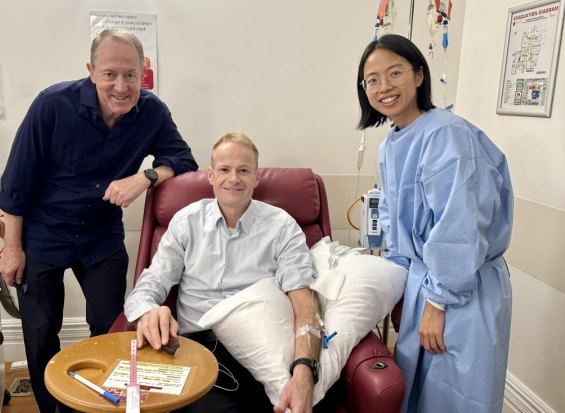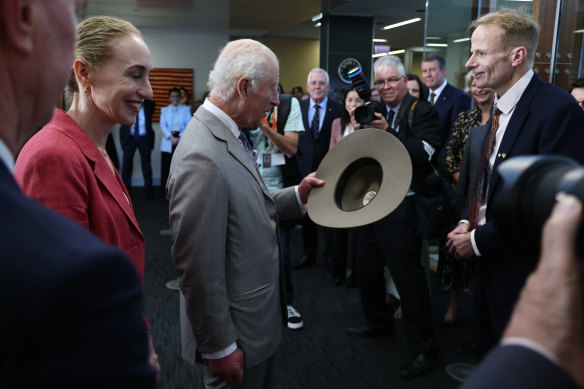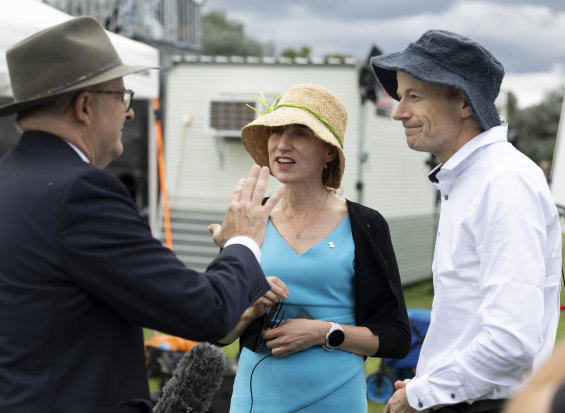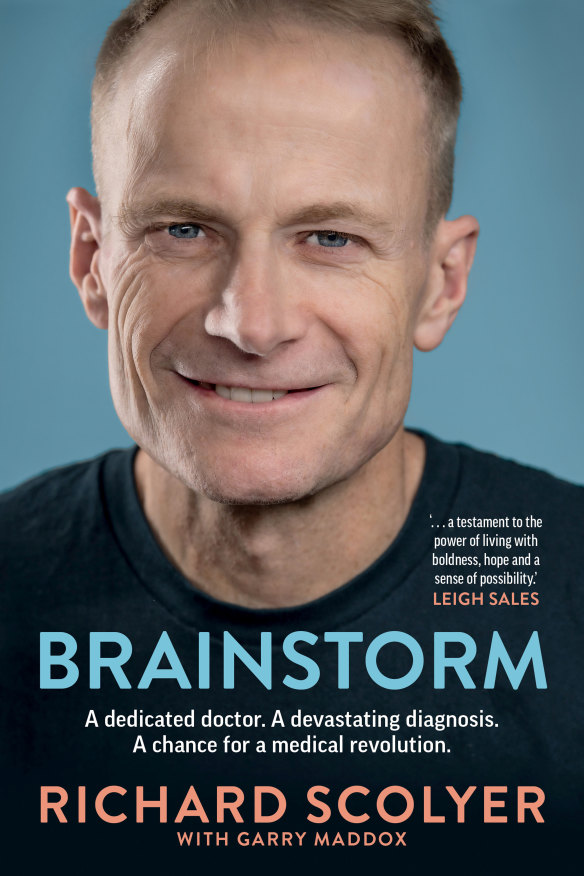
Taking the bike was a last-minute decision. After a restless night, I had slept in and was late for our local Parkrun. I saw my son Matt jogging out the door and knew he’d be too far ahead to catch up with by the time I was ready, so I jumped on my bike.
I was riding on the Parramatta Road footpath, heading quickly down Taverners Hill, when – bam! – I hit a bump. In what felt like slow motion, I went over the handlebars and landed heavily on my head. Ohhh no! I was sliding. This is bad! I stopped and saw my bike cartwheeling across two lanes into the traffic. Body hurts. I was dazed.
Picking myself up, I worked out what damage I’d done. I was wearing a helmet, so my head was OK. I felt grazes on my face, legs, hands, elbows and right shoulder. I was alive but not in great shape. I dragged my bike off the road, where it had been holding up the traffic.
In shock, I sat down against a fence beside the footpath and caught my breath. A few minutes later, a friendly kid and his dad arrived with a first aid kit. I said something like “Thanks, I’m fine” – but I wasn’t sure I was. I got back on the bike, gingerly.
I rode to the Greenway Parkrun at Haberfield but had missed the start. I chained up my bike and, still recovering, jogged to catch the walkers at the tail of the field. My mouth was dry. I could see blood on the back of my hands. I touched my cheek. More blood.
I saw people I knew, including Matt, heading back in the opposite direction to the finish while I was still running to the turnaround. When they were close, I saw some of them mouth “hello” then reel at what I looked like.
It was Saturday, January 20, this year. Any day was a bad day to have a bike crash, especially going downhill at more than 30 kilometres an hour; especially when you were a supposedly responsible doctor, medical leader, husband and father; especially when you were going through revolutionary brain cancer treatment. But this was an especially bad day because, in three days, I was due to head to Canberra with my wife Katie and the kids for the announcement of the 2024 Australian of the Year.
Loading
I’d been sent a schedule with a packed program of events to attend before Prime Minister Anthony Albanese announced the Local Hero, Junior Australian, Senior Australian and Australian of the Year on Thursday night. Lots of meeting famous people, lots of mingling, probably lots of explaining about my brain cancer and my treatment.
Taking it v-e-r-y-y-y-y steadily, I ran 5 kilometres in 27 minutes flat. Even banged up, I couldn’t help feeling disappointed by my time. But I made it, which hadn’t seemed likely when I’d gone over the handlebars.
Walking the bike home with Matt, I could feel a depression in my cheekbone and feared it was broken. Back home, Katie wanted to get me to RPA as soon as possible. Radiology scans showed my cheekbone wasn’t broken. There was also no bleeding in my brain. But radiologist Elizabeth Thompson told me I had a vertical fracture in the C6 vertebral body in my neck. Wow, I just did Parkrun with a broken neck!
X-rays as I flexed and extended my neck showed I had what’s called a stable fracture, meaning there was no risk of damage to my spinal cord from the bone moving. I headed home wearing a neck brace and rested.
On Monday, Katie and I saw my neurosurgeon, Associate Professor Brindha Shivalingam, at Chris O’Brien Lifehouse. Despite her usual calm and sympathetic manner, she was clearly exasperated. I’d been lucky, she said. Thankfully, she was fine with me going to Canberra, and, because the fracture was stable, I didn’t need to wear the neck brace.

“Revolutionary brain cancer treatment”; Richard Scolyer with Brainstorm co-writer Garry Maddox and nurse Shanshan Zhang. Credit: Brainstorm/Allen & Unwin
Professor Georgina Long, my fellow co-medical director at Melanoma Institute Australia, joint Australian of the Year nominee, friend and my medical oncologist for the world-first treatment for my brain tumour, was shocked to hear about the fracture but relieved the damage wasn’t more serious.
On the advice of Jen Durante, who handled communications for the institute, we decided to keep the broken neck quiet outside family and close friends. It would be a distraction during media interviews in Canberra and we wanted to stress the importance of sun safety and the dangers of tanning.
The first event in Canberra was at the National Museum of Australia, where the Australian of the Year exhibition was running. We’d met most of the other nominees at the exhibition launch before Christmas, but this was a chance to learn more about their inspiring lives.
There was also a dinner but functions at night were tricky for me. With a recently increased dosage of one anti-epileptic medication and a new one to get my partial seizures more under control – both of which had a sedative effect – I’d been heading to bed early. Before dessert, Katie escorted me back to the hotel in an Uber so I could sleep.
Next day there was a lunch for Australian of the Year nominees at the swanky The Boat House restaurant, an afternoon function at the Australian War Memorial, and then a special moment at Old Parliament House: we had our photos taken beside flags carrying our portraits. Afterwards, we headed to a stunning reception at Government House, where then-governor-general David Hurley made a heartfelt speech about the importance of the awards. I needed another Uber back to the hotel before the reception finished.
While Georgina and I doubted we would win, all the nominees had to prepare a speech just in case to say what we’d like to achieve with the award. With the bike crash and Georgina seeing her melanoma patients on Monday, our speech was still unfinished.
On the day of the ceremony, we headed to a morning tea hosted by Prime Minister Anthony Albanese and his partner (later fiancée) Jodie Haydon for nominees at The Lodge. After lunch, Georgina and I finally had time to practise our speech. But, agreeing we weren’t going to win, we cut it short.
Arriving at the National Arboretum that evening, I had a taste of what it must be like to be famous when we had our photos taken on the red carpet. Katie and I were quietly amused at how our lives had changed. For a moment, I remembered that my broken neck could have stopped me even coming to Canberra, and was glad I’d made it.
The auditorium was abuzz with formally dressed guests and waiters. After a warm Welcome to Country by Aunty Violet Sheridan, the very deserving winners of the first three categories were announced. David Elliott, the co-founder of the Australian Age of Dinosaurs Museum in Queensland, was named Local Hero; champion swimmer Emma McKeon won Young Australian; and Aboriginal community leader Yalmay Yunupingu was Senior Australian of the Year.

Professor Scolyer inside his lab this week.Credit: Dion Georgopoulos
My heart was in my throat when it was time for our award. The prime minister opened the envelope: “The 2024 Australian of the Year, I’m proud to announce, is Professor Georgina Long and Professor Richard Scolyer.”
Fireworks went off inside my head. I stood, kissed Katie and our daughters Emily and Lucy, hugged Matt and walked to the stage with Georgina amid handshakes and warm applause. We were both overwhelmed by a standing ovation.
Then came the speech we didn’t expect to need. Georgina and I wanted to stress the importance of sun safety to a national TV audience. “Tomorrow, thousands of Aussies will be soaking up the sun, working on their tans,” she said. “Or, as we see it, brewing their melanomas.”
Then I got personal. “I stand here tonight as a terminal brain cancer patient,” I said, feeling the room get even quieter. “I’m only 57. I don’t want to die.”
The emotion was almost too much – it always felt raw talking so directly about dying – but I continued. “I love my life, my family, my work. I’ve so much more to do and to give.”
Georgina then said something that still rattled me months later: “Richard, I hope for nothing more than the both of us, in 12 months’ time, to be standing here, passing the baton to the next Australian of the Year.”

Scolyer, right, talks to King Charles when he visited the Melanoma Institute of Australia in Sydney this week.Credit: AFP
I felt so many emotions – humility, joy, pride, love and momentary despair that I may not make it to a year – as we received another standing ovation. The other winners – David, Emma and Yalmay – joined us on stage as the ceremony finished.
The next half-hour was a blur of interviews and congratulations before some quiet time in a small room where the head of the National Australia Day Council, Mark Fraser, and publicist Nicole Browne talked to us about how our lives were about to change. “It’s been a bit of a wild ride, right?” Mark said. I couldn’t argue with that.
It was already way past my anti-epileptic-induced bedtime, but Nicole said we had to be in the hotel foyer at 5.10 am for back-to-back interviews at Parliament House. I tried to process everything that had happened and everything that would happen in – I checked my watch – seven hours.
Half asleep, I came to life when radio and TV interviews around the country started at 6.30am. Every one was different, but the common subjects were in our bones – the dangers of skin cancer, the difference we were trying to make and my brain cancer treatment. The elation of the night before carried us through the schedule.

Prime Minister Anthony Albanese speaks with 2024 Australians of the Year, Professor Georgina Long and Professor Richard Scolyer in Canberra on Australia Day.Credit: Alex Ellinghausen
By 9am, we were at a citizenship ceremony by Lake Burley Griffin. After the moving experience of seeing proud new Australians receiving their citizenship, we were delighted to see the prime minister and many other VIPs wearing hats to protect their skin from the sun on a warm morning. I made a mental note to suggest they have more shade cover for guests next year.
Then it was a flight back to Sydney for the Australia Day Live concert outside the Opera House.
Before it, I loved seeing our kids getting photos with the prime minister and NSW Premier Chris Minns. We were taken to VIP seats – another first! – for the concert. When I started to feel cold, which could mean a seizure was coming on, I had to move inside.
Having been up since 4.30am, I only just stayed awake for an interview with the ABC’s Jeremy Fernandez for the telecast then I had to go home immediately. The council had lined up a golf buggy to take me through the crowd to meet a driver, but I needed to go straight away so I said I’d walk. A surprised policewoman organised a scrum of officers around me as I headed to Macquarie Street. Then home. And exhausted sleep.
I woke early, as always. With the rest of the family asleep, I decided to head to the regular Saturday Parkrun – walking this time. I needed to decompress after the busyness of the past few days.
Loading
There was a fuss at the start but I couldn’t make out what was being said in the crowd, so I set off to walk-and-maybe-jog-just-a-little on the grass beside the path. I still had a broken neck, so I didn’t want to jar it. As I reached the finish – embarrassed by how slow I’d been – I saw other runners lining the finish chute. It was a guard of honour! I almost cried as they warmly applauded me over the line.
From one Parkrun to the next, something exceptional had happened. I wasn’t famous like some of the people I’d been mixing with in Canberra, but I’d become better known. It felt like people I didn’t know, who wouldn’t have recognised me seven days ago, were on my side. It felt like they wanted me to get through this. I hoped I could.
Edited excerpt from Brainstorm, by Richard Scolyer with Garry Maddox, published by Allen & Unwin on October 29.
Start the day with a summary of the day’s most important and interesting stories, analysis and insights. Sign up for our Morning Edition newsletter.

BrainstormCredit: Allen & Unwin




























